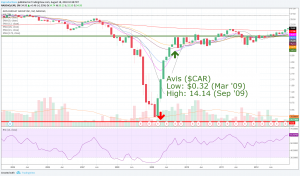First Published: August 20, 2018. Last Updated: March 8, 2021
Now, You Can Watch and Read this Article!
Click the video to learn about cash on the sidelines or read the article below!
What are Quality Stocks?
So, you’ve invested your first $10,000 in a S&P 500 tracking fund or in some other diversified asset class that gives you exposure to the entire market.
Excellent!
Now, you’re ready for the next step – taking the additional money you want to invest and picking single stocks in the market.
But, where do you start? What makes a quality stock?
Quality versus Quantity (Amount invested vs. number of shares)
Many investors get wrapped up in the concept that they need to buy a lot of shares in a company in order to get the best return, so they stick with low-priced stocks (which are almost always low-quality) instead of putting the same money in a quality stock of a quality company.
As you proceed down the path of investing in your financial future, you will begin to learn first-hand that quantity isn’t as important as quality. You want to earn the biggest percentage return on your investment.
When researching stocks, the number of shares you can afford is irrelevant. Instead of thinking about the number of shares you want to own, think about the amount of money you want to invest. If you invest $1,000 in a $1.00 stock and $1,000 in a $1,000 stock and they both go up 10%, you make $100.
It doesn’t matter that you owned 1,000 shares of the lower-priced stock and 1 share of the higher-priced stock.
Low-priced stocks are not necessarily “cheap”
Many investors think a “cheap” stock is one with a low price. A stock’s price has very little to do with whether or not it’s cheap.
In order to determine if a stock is cheap, you need to look at factors such as the quality of the company behind the stock, their earnings, their future growth outlook, whether they’re the leader in their industry, and what news has happened to a stock recently.
Low-priced stocks that used to be higher-priced are usually indicators of a company that’s in trouble. It can be tempting to look back at a stock’s price history and imagine how much money you will make if the stock returns to its old highs, however most stocks that drop in price to incredibly low levels do so because the company’s in trouble. A good rule of thumb is that you don’t care where a stock’s been, you care where it’s going.
IMPORTANT: Low-priced stocks are never to be confused with “cheap” or “inexpensive.” Low-priced stocks are usually priced that way for legitimate reasons.
Don’t go chasing unicorns
Many new investors make the same common mistake – trying to find unicorns.
A unicorn is a stock with a low price that will allow investors to buy a huge quantity in order to capitalize on an unexpected jump in price resulting in dramatic returns.
Many investors start the process of investing wild-eyed with big dreams of huge profits. Excited about getting started and seeking huge gains in a short time-frame, new investors often make the mistake of trying to find unicorns stocks without considering the fact that most stocks whose price drops below $1.00 never return.
The Last Unicorn?
 Let’s look at the curious case of Avis Budget Corp ($CAR), a rental car company whose stock dropped to a low of $0.32 in March 2009 in the middle of the recession before springing up to $14.14 in just six short months by September. Investing just $1,000 at $CAR’s lows would have yielded a position worth $44,187.50 – a return of nearly 4,200% in an incredibly short time!
Let’s look at the curious case of Avis Budget Corp ($CAR), a rental car company whose stock dropped to a low of $0.32 in March 2009 in the middle of the recession before springing up to $14.14 in just six short months by September. Investing just $1,000 at $CAR’s lows would have yielded a position worth $44,187.50 – a return of nearly 4,200% in an incredibly short time!
Although those returns are certainly mouth-watering, historically, stocks that drop below $1.00 per share never return from that price rather than jumping in excess of 4,000% more often than not.
Buying $CAR at $0.32 would have been incredibly risky with no outlook of survival for the company, at the time. Thanks to a series of lucky breaks, $CAR received an explosion in its price – analysts had mispriced the stock, investor expectations were incredibly low, and the company performed a variety of other unique (“lucky”) strategies to regain their holding. Not to mention we were in the middle of a once-in-a-generation recession dramatically affecting almost every stock’s valuation.
The above factors in $CAR are not found in the majority of low-priced stocks, and we certainly don’t have a recession to rely on for low valuations in the current market.
Although the idea of picking a unicorn stock is incredibly exciting, the long-term investor will be better-served looking at the stocks of excellent-performing companies with a track record of excellent returns, a strong outlook on the future, an excellent product or service line-up, and loyal customers.
The returns are typically not nearly as explosive in quality stocks, to be sure, but the downsides are magnitudes safer than losing an entire investment in a sub-$1.00 stock.
A Quality Stock starts with a Quality Company
Instinctively, many investors have a feeling of what makes a quality stock because they’ve heard of the company or use its products.
This familiarity created the investment adage: “Invest in what you know.” Although not the best method of choosing stocks on its own, the adage provides a good starting point to find stocks with consistent, positive returns.
If you’re already familiar with a company’s products or services, you’ll start your research already knowing more about the company’s background. Additionally, investors are more likely to stay up-to-date on companies they know, in opposition with smaller unknown companies whose products and services investors might not be familiar with or don’t use.
Get Diversified
A quality portfolio for the long-term investor will have 5-10 positions representing the best-of-breed (highest-quality) companies in non-overlapping sectors. By not owning more than one position in a single sector, your portfolio is protected from a specific sector-wide sell-off, a method called “Diversification” by Jim Cramer of CNBC’s Mad Money.
Long-term investors should be looking for stocks that will carry them through the next 10, 20, or 30 years, sometimes longer if you started investing early enough (or, like Get Irked, don’t think you’ll be able to retire quite as soon as you’d like to).
Below is a portfolio of some of Get Irked’s long-term positions that have proven very successful over a timeframe of up to six years. All prices are split-adjusted to represent current market pricing (over the six years, Apple ($AAPL) split 7:1 and Nike ($NKE) split twice at 2:1 each time).
IMPORTANT: Not only is none of what Get Irked posts to be considered investment advice, a stock’s past price performance isn’t necessarily an indicator of its future performance. Get Irked is not an investment adviser – we just write what we’ve experienced ourselves.
Apple ($AAPL)
Sector: Consumer Technology Products and Services
Position opened 4/18/2013: $56.66
Closing price on 8/17/2018: $217.58
Gain: 384.01% over five years
Boeing ($BA)
Sector: Aerospace
Position opened 2/14/2012: $79.85
Position added to on 6/21/2012: $70.39
Cumulative position price: $75.28
Closing price on 8/17/2018: $346.40
Gain: 460.14% over six years
Disney ($DIS)
Sectors: Media Entertainment, Theme Parks, Television Networks
Position opened 2/14/2012: $41.87
Position added to on 7/17/2013: $67.53
Cumulative position price: $47.86
Closing price on 8/17/2018: $112.48
Gain: 235.02% over six years
Nike ($NKE)
Sector: Apparel
Position opened 2/14/2012: $26.82
Position added to on 6/21/2012: $25.41
Cumulative position price: $26.32
Closing price on 8/17/2018: $79.75
Gain: 303.06% over six years
Square ($SQ)
Sector: Businesses Services, Financial Technology (“fintech”)
Position opened 8/5/2016: $11.15
Closing price on 8/17/2018: $72.90
Gain: 653.81% over two years
You’ll notice a few key elements similar in all of Get Irked’s winners:
- All five are high-quality companies. You may be familiar with all five names.
- All five are the leaders in their respective sectors. They may have strong competition, but they are recognized as being the best of their sectors in terms of performance.
- Many return dividends (all except $SQ). This isn’t a requirement, but for the long-term investor, dividends can protect against recession or slow movement in a stock by providing income even when the stock price isn’t moving.
IMPORTANT: Most brokerage houses offer Dividend Reinvestment Programs (DRiPs) where the brokerage will give you a stock’s dividend in fractional shares rather than cash. Always choose this option. The fractional shares you receive will earn dividends over time, compounding your earnings.
- Positions were often added to. Sometimes, as in the case of Boeing and Nike, we added to the positions because their share price dropped below our per-share cost. In Disney’s case, we added to the position after reviewing the company and deciding it held significant future growth opportunities.
- Always do your homework. Even with long-term investing, you should never “buy and hold,” you should “buy and homework.” Regularly check in with your positions by reviewing company-specific news, sector news, and market news to decide whether to add to the position, hold the existing quantity, or sell some (or all) of the position.
Where do you go from here?
Get out there and start researching your favorite companies to find stocks you’d like to buy. We recommend using a free financial website (our favorite is Yahoo Finance over Google Finance) to look at company profiles, news, earnings, past performance, and much, much more.
Do you have a stock you’re interested in and would like an outside opinion? Feel free to share it in the comments!

Disclaimer: Eric "Irk" Jacobson and all other Get Irked contributors are not investment or financial advisers. All strategies, trading ideas, and other information presented comes from non-professional, amateur investors and traders sharing techniques and ideas for general information purposes.
As always, all individuals should consult their financial advisers to determine if an investing idea is right for them. All investing comes with levels of risk with some ideas and strategies carrying more risk than others.
As an individual investor, you are accountable for assessing all risk to determine if the strategy or idea fits with your investment style. All information on Get Irked is presented for educational and informational purposes only.


You must be logged in to post a comment.